FACT: “The number of people that can survive on less than 7 hours sleep without showing any impairment rounded to a whole number expressed as a % of population is 0.”
Matthew Walker
An assortment of habits and behaviours around sleep will affect your sleep performance, as with anything in life. Behaviours such as sleep consistency, diet, timing of exercise and meals, morning and evening routines will all have contributing effects. These very same behaviours and routines can get disrupted by the generalised anxiety and unpredictability such as we are experiencing with this latest Covid outbreak. However, I want to begin by looking at exactly what makes us sleep and how we can improve our relationship to sleep.
Today we take a look at four of the main factors or levers involved in this process;
Sleep drive
Circadian rhythm
Exposure to natural light
Temperature minimum.
My approach is different, you may not be too familiar with these aspects of sleep but being fascinated by all things neuroscience and how we work; here is a slightly different perspective. Remember I am only touching the surface of this gargantuan topic in todays article.
My biggest challenge is knowing when to stop. Here goes!
1. Sleep Drive or Sleep Hunger
In a nutshell, Adenosine is an inhibitory neurotransmitter, building up in your system from the moment you wake until you can no longer help but fall asleep. When Adenosine is high we are sleepy having traversed our entire day and low when we are alert and ready to go after our sleep. Take a moment to think about how you wake up. Do you wake up refreshed or do you feel like you still need more rest?
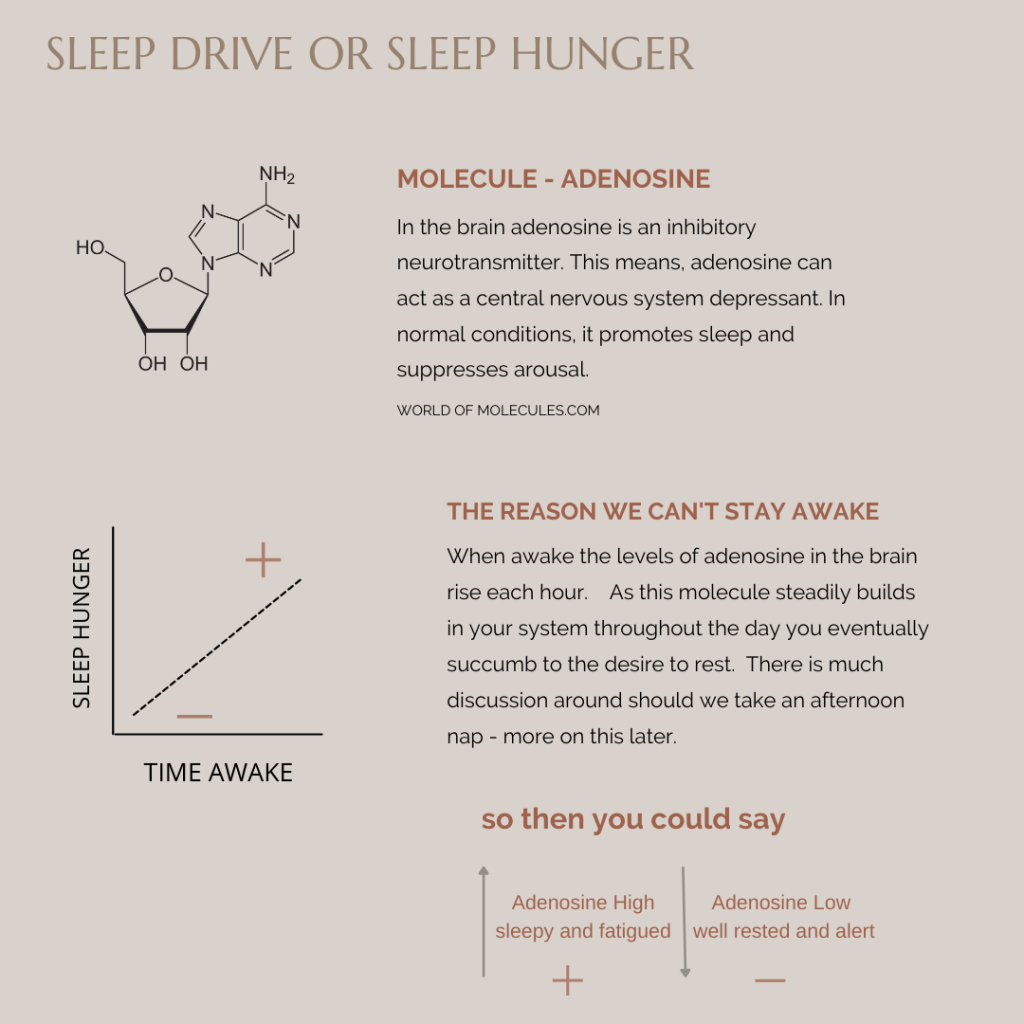
That mid afternoon nap should now be self explanatory. Be careful not to sleep more than 20 minutes and no later! That mid afternoon nap can disrupt your night time sleep routine.
Side track – – – Ever wondered why we love to reach for a coffee in the morning (well I do any way).
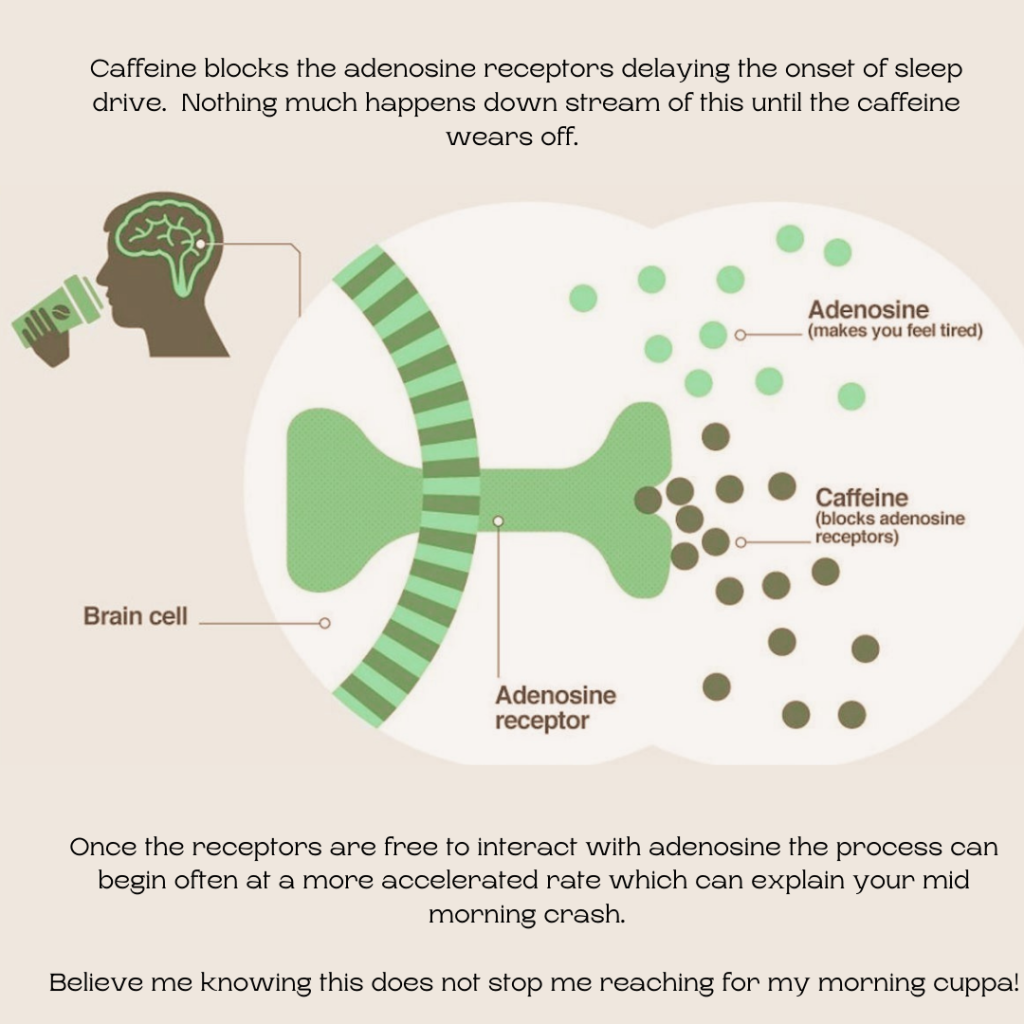
Remember caffeine has a different impact on everybody. It is very individual. I would suggest have your last coffee in the morning so far as sleep architecture is concerned. However, some can drink coffee after dinner and still get a good nights sleep. You are the best just of what works for you.
2. Circadian Rhythm
Our entire system works on a 24 hour clock. We have a clock inside every single cell in our body! Imagine that. This rhythm works on 90 minute cycles which occur roughly over the 24 hour cycle. Sleep is such an individual experience. We used to believe that sleep will last around 5 of these cycles or 7.5 hours however, science seems to be turning these specifics into generalisations. It is all up for grabs.
Basically, our body clock is primed to wake up with the sun and fall asleep with the moon. The interplay of Melatonin and Cortisol seesaw endogenously (without our input) through out our cycle. Of course many of us no longer live in alignment with the rhythms of nature due to our work hours, nightshifts, cross timezone commitments, artificial lights etc. So you see, we are already starting to understand why sleep may, for some be illusive and irregular.
Whether you are a lark or a night owl, a teenager, a new parent or during menopause and everything in between you will need to address your sleep habits to optimise health wherever you can.
For us today, we are going to keep an open mind as we circle around this cycle.
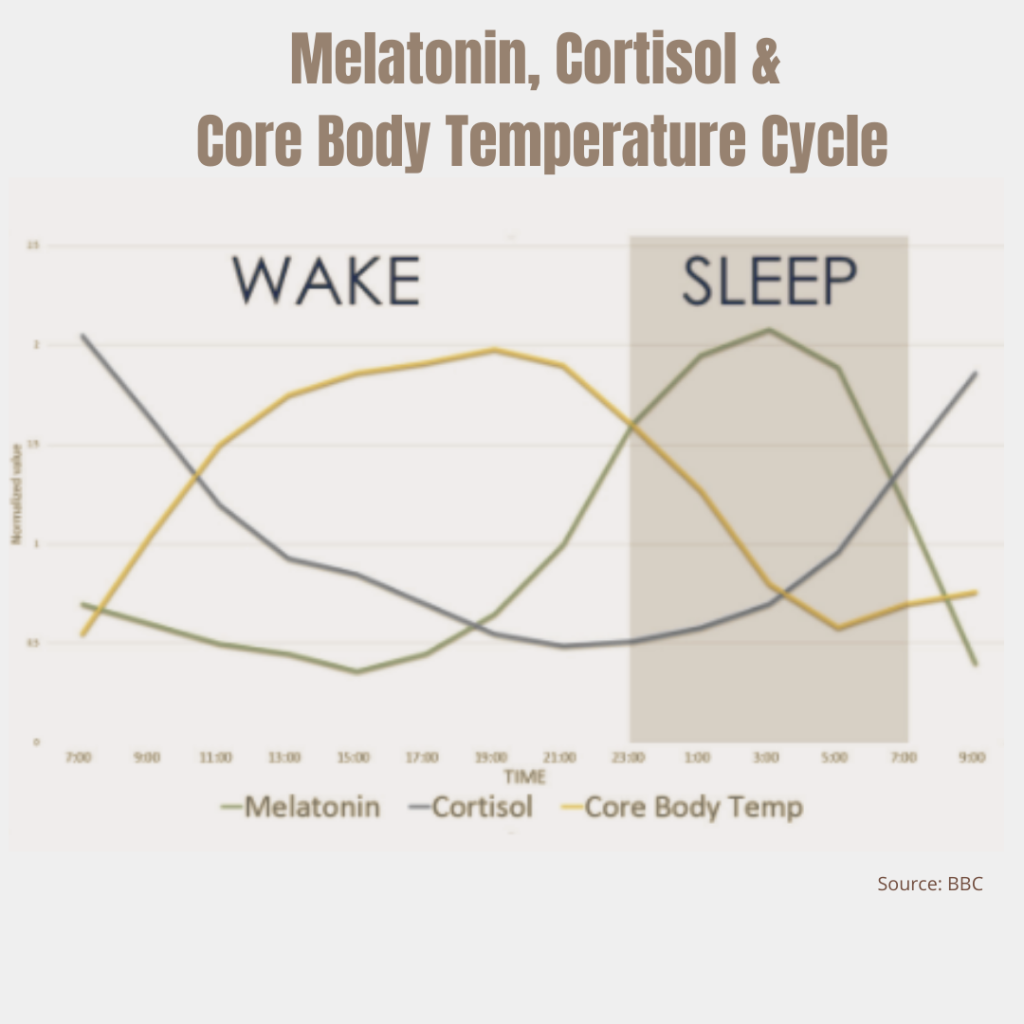
Now we know that cortisol gives us a bit of a push in the morning to get us out of bed so yes, a little bit of stress can be a very good thing. Here we explore this in more detail. Remember we are now setting off on the first leg of our circadian rhythm for the day . . . Let’s push on . . .
The Waking Mechanism
On waking we receive a pulse of cortisol (the hormone released from the adrenal glands) to wake us up and motivate us into action. It is very important that the cortisol signal early in the day to get on top of the cyclical rhythm. The later the signal the later the cortisol drops off in the evening causing potentially non-optimal sleep behaviours.
Now here is the REALLY cool bit, at the same time the cortisol signal goes off, so does a cellular timer that alerts your brain and nervous system that in roughly 12 – 14 hours or so another hormone Melatonin will begin to be produced from the Pineal gland. Signalling the onset of sleepiness.
Back to our morning, Epinephrine is released from the Adrenals stimulating us to become more alert and focussed. This helps us function throughout the day.
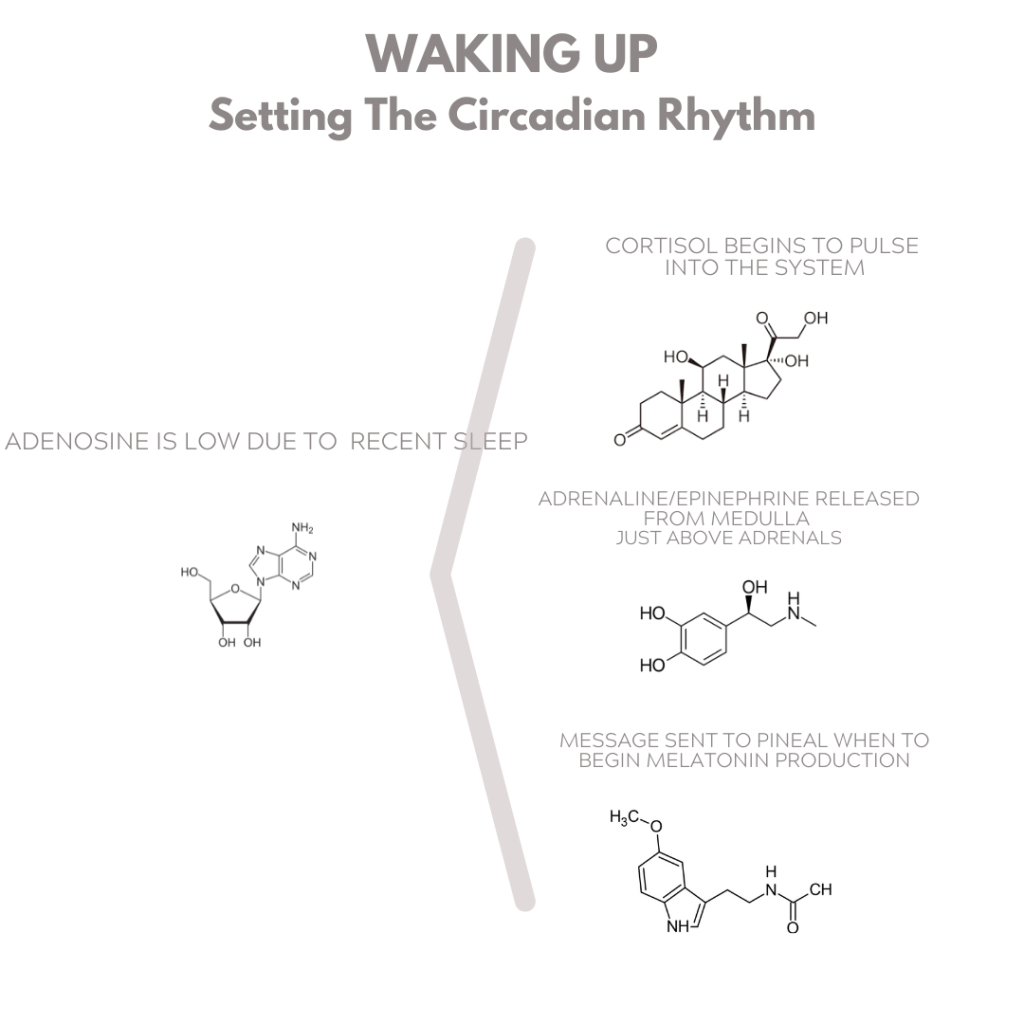
Now what do you do first thing in the morning? Yes, you open your eyes. Light enters the eyes through the retinal ganglion cells. These cells are at the back of your eyes, outside your skull but still a part of your nervous system.
They send a message to the central clock which sits at the top of your mouth called the “suprachiasmic neucleus” (such a great name) which has connections with every cell in your body. That’s how your organs, tissues and cells can tell the time!
And that my friends is how you wake up! From this point on there are cascades of hormone systems and neurotransmitters in the body that make you awake at certain times of the day and asleep at others and they want to work with you to create your optimum health.
3.Natural Light Early in the Day.
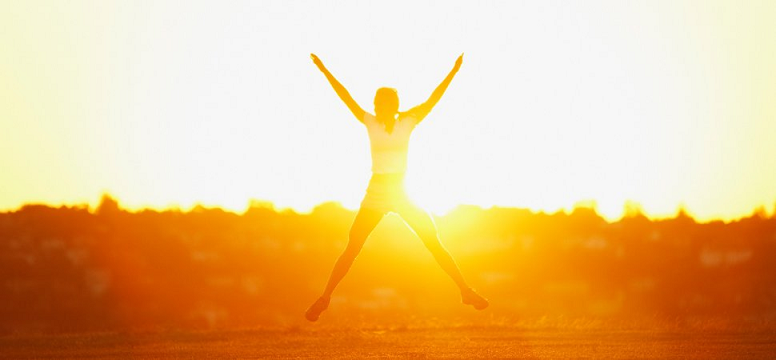
So it turns out that the best time to get quality light activating the cortisol pulse is when the sun is low in the sky or “at low solar angle”. Which is ideally at or a couple of hours after sunrise.
If you cannot do this don’t despair try to get some light energy as early as possible into your eyes. Always making sure it is safe to do so. Obvious alert! Never look directly at strong light. Get as much light as possible during the day particularly during low solar angle. If you can’t turn on artificial light during the day to get as much light as possible in to your system. We are shooting for 100,000 lux before 9am if possible.
The combination of yellow and blue wave light photons at this time are optimum for relaying messages via an electrical signal to the neurons in the eyes which signal the circadian clock.
Andrew Huberman, Neurobiologist & Opthamologist, Stanford.
According to Dr Jamie Zeitzer – Associate Professor (Research) of Psychiatry & Behavioral Sciences (Sleep Medicine) Stanford, it is 50x more effective to view light directly than through sunglasses, car windsheilds or windows. So get out there even just as far as your front door but view the light directly where possible not through windows or windscreens. Perhaps eat breakfast or have your morning coffee outdoors?
“Instead of artificial light go outside. Even if there is a lot of dense cloud cover you are probably getting anywhere from 10,000 to 50,000 lux and that should be sufficient to set the circadian clock”
Andrew Huberman
4. Temperature Minimum
Do you know your temperature minimum? If not you should. Why? Usually our temperature is at its lowest around 1.5 to 2 hours before we wake up. So, if you wake up regularly at 6am typically your minimum body temperature would be anywhere from 4am to 4.30am. Your temperature will continue to rise throughout the day reaching its maximum sometime around mid afternoon and so begins the slow decline in temperature until you reach your lowest temperature 90 mins to 2 hours before waking.
Temperature minimum time can be used to reset your circadian rhythm. It turns out that we can reset our own body clock by moving a few levers such as light, timing of exercise and food and temperature is a very important lever. Again, its free and you don’t need to take a pill.
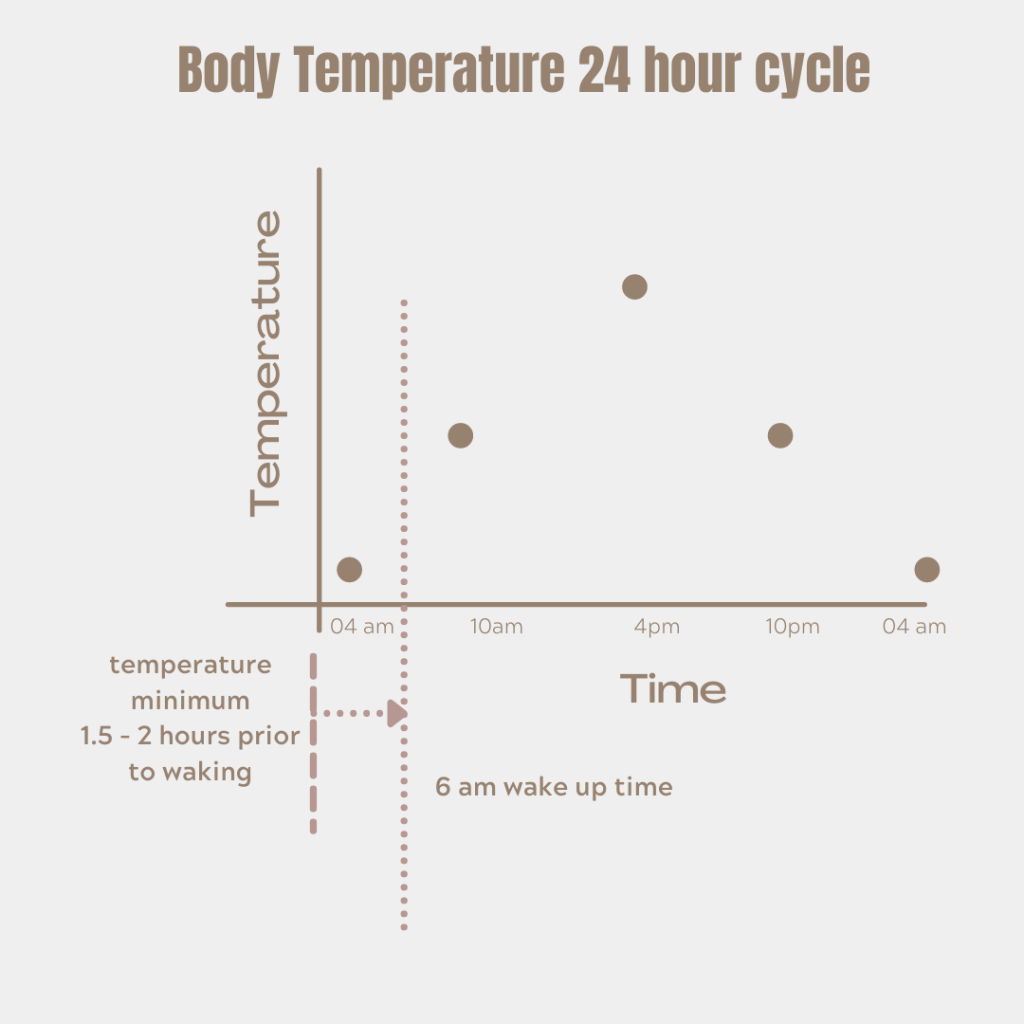
Temperature minimum does not mean taking your temperature – you don’t even need a thermometer! Rather by approximating the time your temperature is at its lowest. By tracking your wake up time over 3 to 5 days and then getting the average you can then calculate when your minimum temperature will be.
If you view light in the morning up to 4 – 6 hours after your temperature minimum you will want to get up earlier the next day and go to sleep earlier. If you view light in the evening from 4 – 6 hours before your temperature minimum (which could be anywhere from 10 to 12 pm in our example) you will want to wake up later and go to bed later. The temperature minimum is your reference point – your lever to affect change.
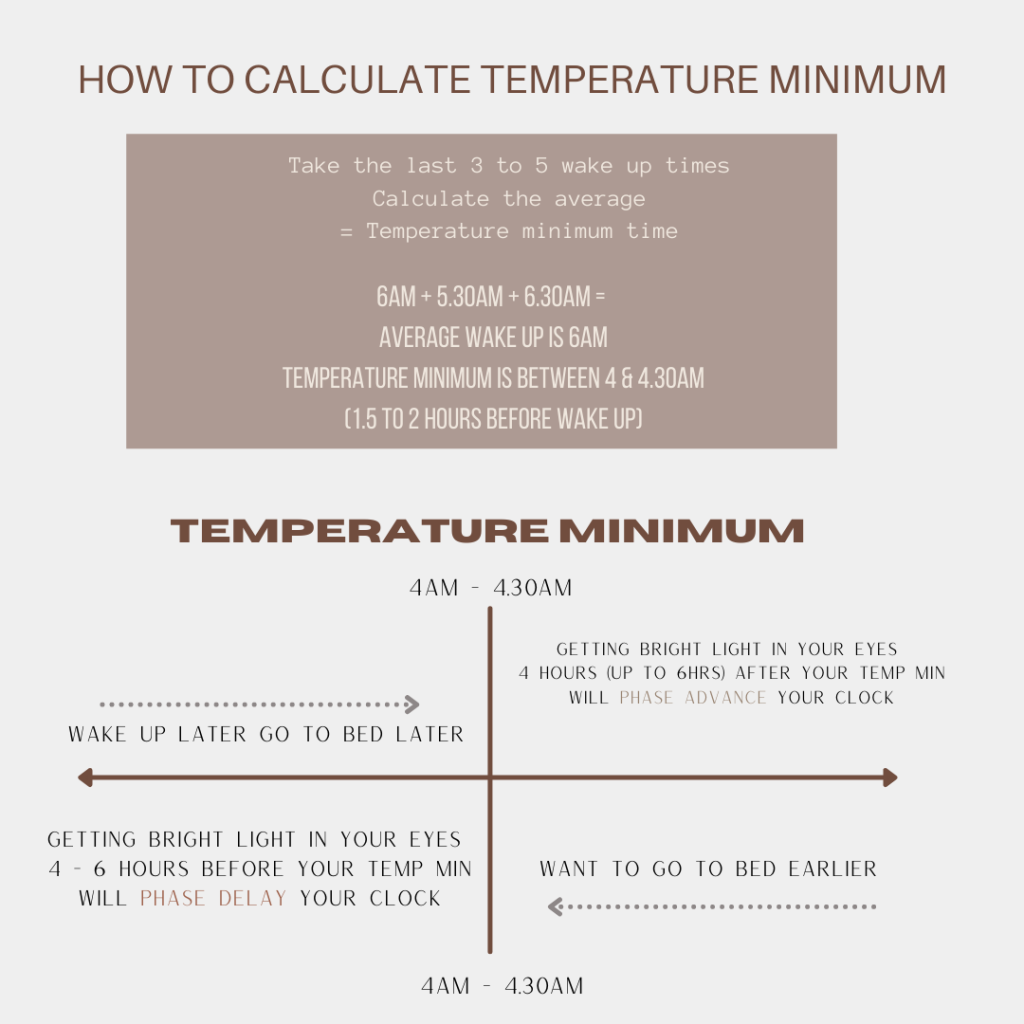
If you travel for work (increasingly unlikely), do shift work or if your clock is so out of whack that you need to reset the entire system this is how you do it. Teenagers are a classic example of being up too late at night and finding it really difficult to get up in the morning. (Tip – if you have a teenager try flicking the light in their bedroom a few times up to 20 minutes before they wake up – or leave the light on. Although you can only receive light information through your eyes astonishingly it is possible for this to register thus causing small phase advances). By getting light in your eyes 4 to 6 hours after your temperature minimum you can bring your circadian rhythm forward so you want go to bed earlier that night this is called “phase advance”. Waking up earlier will make you want to go to bed earlier. Similarly, getting light in your eyes 4 – 6 hours before your temperature minimum point during the night will cause you to “phase delay your cycle” thereby making you go to bed later.
You see where this is heading. If you need to travel or you are no longer in sync with the with the light dark cycle you can manipulate your temperature minimum to assist you to the correct time zone for your lifestyle or location. Using your temperature minimum can help you move toward or away from the rhythm that no longer works for you. Do this for three days and you will see a shift in your wake up time. Again, it will be different for everyone but try recording your wake up time for 3 or 5 days and this will allow you to get an accurate reading of temperature minimum and shift your clock in the desired direction.
If you would like to learn more about any of the above topics in preparing this work I have researched the work of:
- Andrew Huberman – The Huberman Lab, Neurobiologist & Opthamologist, Stanford
- Joe Takahashi – Neurobiologist and Geneticist, University of Texas Southwestern Medical Centre & Investigator at the Howard Hughes Medical Institute
- Satchan Panda – Salk Institute, Executive Center for Circadian Biology at the University of California, San Diego
- Jamie Zeitzer – Dr Jamie Zeitzer – Associate Professor (Research) of Psychiatry & Behavioral Sciences (Sleep Medicine) Stanford.
- Matthew Walker – Professor of Neuroscience and Psychology at the University of California, Berkeley
- Sarah McKay – Neuroscientist
Summing Up
I encourage you to continue your journey in to sleep research. I have not even scratched the surface, but I hope I have shown you a little of the fascinating information is coming out of the field of sleep science. We can no longer afford ignore our sleep health particularly at times like these
I could go on but I will leave that to you. Please feel free to contact me if you would like any further sleep tips, yoga poses and routines for morning and night.
Please follow our instagram, facebook and linked in pages as I will be putting sleep tips on our socials every night this week.
Thank you for your time and I look forward to tomorrows Edition of 7 days of Wellness where we explore your daily routines. We will move past the waking stage and in to optimising your day through ritual and routines.
Stay well.
Sandra